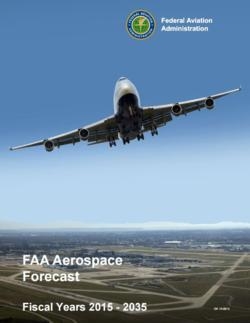Fri, Mar 20, 2015
Agency, Industry Priorities In Place To Meet Demand
The FAA has released its annual aviation forecast that shows the nation’s aviation system will continue to grow over the next two decades with greater numbers of people expected to fly more miles each year.

“The improving economy continues to bode well for the health of the U.S air transportation system,” said FAA Administrator Michael Huerta. “The FAA and industry are continuing to deploy NextGen technologies and procedures to ensure that the nation’s aviation system can safely and efficiently meet our growing airspace demands.”
Revenue Passenger Miles (RPMs) are the aviation standard for measuring air travel volume. An RPM represents one paying passenger traveling one mile. The FAA Aerospace Forecast Fiscal Years 2015 to 2035 projects RPM growth for U.S. air carriers to average 2.5 percent per year over the 20-year forecast.
Load Factor is a term that represents the average percentage of seats filled in commercial passenger aircraft. The report concluded that U.S. air carrier Load Factors were an estimated 83.4 percent in 2014. Load Factors are projected to grow to 84.2 percent by 2035.
U.S. airlines served an estimated 756.3 million passengers in 2014, up by 2.3 percent from the 2013 level. The FAA forecast projects passenger growth to average 2.0 percent per year, reaching one billion passengers in 2029, and 1.14 billion by 2035.
To help the FAA and the aerospace system better prepare for the forecast growth and future changes, the FAA and industry are working together to implement the NextGen air traffic modernization plan. To further expedite this effort, late last year the FAA and industry unveiled the NextGen Priorities Joint Implementation Plan. Under the plan, the agency and industry share responsibility to meet specific milestones, locations, timelines and metrics for “high priority, high readiness” NextGen initiatives. These initiatives include Multiple Runway Operations; Performance Based Navigation using satellites to move aircraft more quickly from point “A” to point “B;” and improved Surface and Data Communications.
Other important data that illustrates the growing demands on our nation’s airspace system is air cargo traffic. As measured by Revenue Ton Miles (RTMs) – one ton of cargo flown one mile – is expected grow to 72.6 billion by 2035 at an average annual growth rate of 3.6 percent during the forecast period. In addition, landings and take-offs at FAA-operated towered airports and FAA-contracted towered airports are expected to increase from an estimated 49.6 million operations in 2014 to 59.9 million operations in 2035, an average rate of 0.9 percent per year.
More News
From 2023 (YouTube Version): Legacy of a Titan Robert (Bob) Anderson Hoover was a fighter pilot, test pilot, flight instructor, and air show superstar. More so, Bob Hoover was an i>[...]
Get The Latest in Aviation News NOW on Instagram Are you on Instagram yet? It's been around for a few years, quietly picking up traction mostly thanks to everybody's new obsession >[...]
Aero Linx: B-52H Stratofortress The B-52H Stratofortress is a long-range, heavy bomber that can perform a variety of missions. The bomber is capable of flying at high subsonic spee>[...]
Altimeter Setting The barometric pressure reading used to adjust a pressure altimeter for variations in existing atmospheric pressure or to the standard altimeter setting (29.92).>[...]
"Knowing that we play an active part in bettering people's lives is extremely rewarding. My team and I are very thankful for the opportunity to be here and to help in any way we ca>[...]
 Classic Aero-TV: Remembering Bob Hoover
Classic Aero-TV: Remembering Bob Hoover ANN FAQ: Follow Us On Instagram!
ANN FAQ: Follow Us On Instagram! ANN's Daily Aero-Linx (05.15.24)
ANN's Daily Aero-Linx (05.15.24) ANN's Daily Aero-Term (05.15.24):Altimeter Setting
ANN's Daily Aero-Term (05.15.24):Altimeter Setting Aero-News: Quote of the Day (05.16.24)
Aero-News: Quote of the Day (05.16.24)



